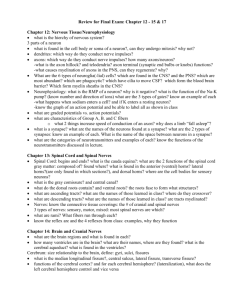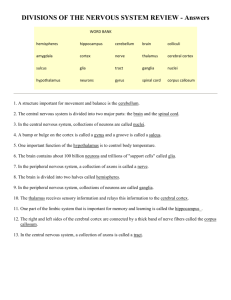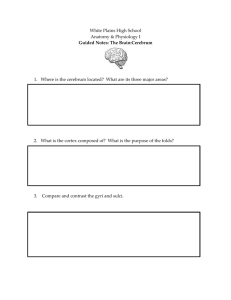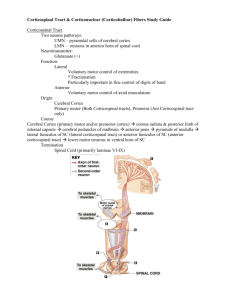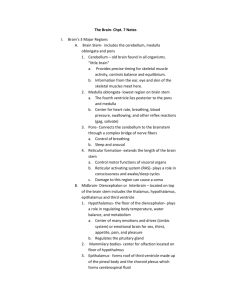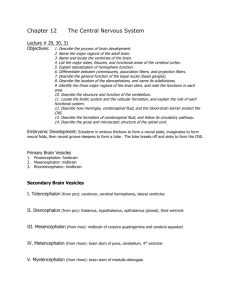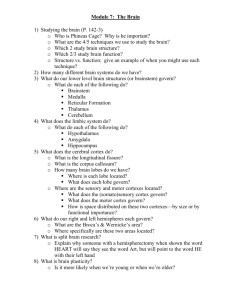Chapter 13- Central NS
advertisement
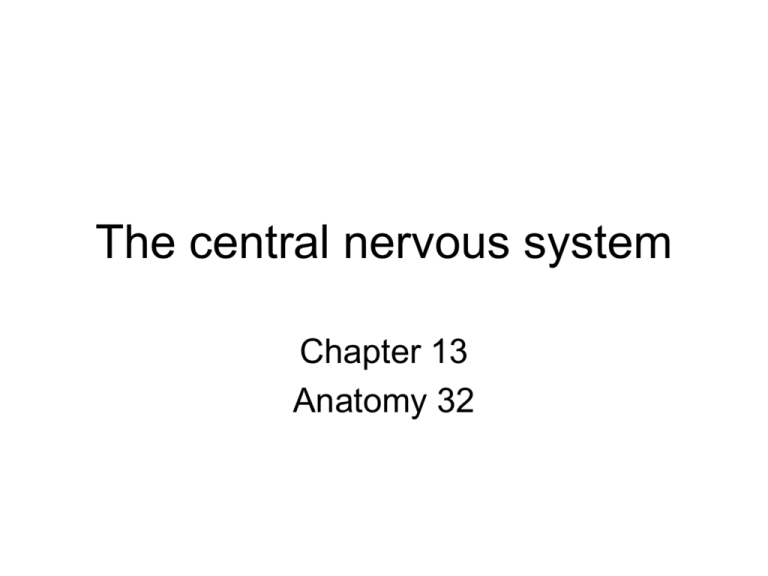
The central nervous system Chapter 13 Anatomy 32 The Central Nervous System I. The brain The most amazing organ is the brain. On average it weighs 3.3lbs. It is not yet completely understood and no type of technology has been able to mimic it exactly. Directional term: rostrally (toward snout ex. frontal lobe) and caudally (toward tail, ex. brainstem). The brain is protected by meninges. A. Embryonic development of the brain and basic organizationduring embryonic development the brain is first formed by several vesicles. As the size increases it folds in to accommodate growth resulting in the structure we know. The vesicle known as the telencephalon (“endbrain”) develops into the cerebral hemispheres. The dienchephalon (interbrain) forms into the thalamus, hypothalamus, epithalamus, and pituitary gland. The brain stem containing the midbrain, pons, and medullary oblongata arises from three vesicles and the cerebellum develops from the metencephalon (“afterbrain”). The wrinkles seen on the brain allow a greater number of neurons to fit in a restricted area. The brain has clusters of gray matter called brain nuclei and sheets of gray matter on the surface. The remainder of the brain is white matter or fluid filled areas called ventricles. The spinal cord also has a concentration of gray matter that resembles a butterfly and fluid that flows through it. B. Ventricles of the brain- these cavities are filled with cerebrospinal fluid. It travels around the brain, goes down the spinal cord and returns up to the brain. The septum pellucidum separates the two lateral ventricles. The third ventricles lie in the diencephalon and the connecting cerebral aqueduct lies in the mesenchephalon. Finally the fourth ventricle and central canal lie within the hindbrain (brainstem). The fluid also flows through the meninges, connecting to the subarachnoid space is the fourth ventricle via the lateral and median aperatures. C. The cerebral hemisphere- This area of the brain is the largest; it covers the diencephalon and shows deep or shallow wrinkles. The line that divides the cerebral cortex into a left and right half is the median longitudinal fissure. Posteriorly, the cerebral cortex is separated from the cerebellum by the transverse cerebral fissure. Grooves or furrows are called sulci and the twisted brain ridges are gyri. Deep sulci divide the brain into lobes. The central sulcus lies on the frontal plane between the precentral and postcentral gyrus; it separates the frontal and parietal lobes. The parietals and occipital lobes are separated by the parieto-occipital sulcus. The lateral sulcus (actually a fissure) separates the parietal and temporal lobe. In most people the left hemisphere has control of language, math, and logic; it deals with the details of the big picture. The right hemisphere has control of visual-spatial skills, intuition, art and music skills, and emotions; it deals with the big picture. The division of control may be more prevalent in males. Both hemisphere communicate via connecting fiber tracts called commissures. 1. Cerebral cortex-composed of six layers of gray matter (primarily interneurons), it controls consciousness and voluntary movement. Brodmann’s structural areas map out different regions of the brain. Studies on brain activity have revealed functional regions of the cerebral cortex in the areas of motor, sensory, and association. MOTOR AREA: a. Primary motor cortex- also called somatic motor area is along the precentral gyrus and contains pyramidal cells. These form tracts that reach motor neurons, they control precise voluntary motor movements. The axons project in a contralateral path (left brain controls right side of body). Areas that control complex skilled movement contain a larger amount of pyramidal cells. b. Premotor cortex- Lies anterior to precentral gyrus. It controls even more complex movements than the primary motor cortex because it integrates highly processed sensory information received from other brain areas. It controls voluntary movement based on spatial arrangement information and is involved in planning movements. c. Broca’s area- Lies in the left hemisphere (language dominant), it controls speech movements, produces mental images of sounds to be spoken, and may also story short-term memory. It’s corresponding side on the right controls the spoken emotional overtones. SENSORY AREA: a. Primary somatosensory cortex- lies along postcentral gyrus, it’s involved with conscious awareness of somatic senses. It is capable of spatial discrimination of sensory stimulus, the information travels contralaterally. b. Somatosensory association area- lies posterior to primary somatosensory cortex. It integrates sensory input for comprehensive understanding by relating it to past experience (ex. Feeling a object and guess what it is without seeing it) c. Primary visual cortex- the largest sensory area lies in the medial part of occipital lobe. It receives all visual information sent by the eye but has low level of processing, the information is sent to opposite sides d. Visual association area- surrouds the primary visual cortex and continues to process information obtained by this area. Multiple visual areas exists throughout that brain that allow the information to travel anteriorly, one pathway process recognition and the other spatial orientation. e. Auditory areas- includes the primary auditory cortex that controls conscious awareness of sound received by receptors in the ear. The auditory association area evaluates/ recognizes a sound and stores memory of sound, a specialized area called Wernicke’s area recognizes spoken words. f. Gustatory cortex- involved in conscious awareness of taste, located in the tongue region of the homunculus. g. Vestibular cortex- involved in conscious awareness of balance, it is found in posterior part of insula. h. Olfactory cortex- involved in conscious awareness of smell, processes by the piriform plate, olfactory tract, and olfactory bulb. A region of the frontal cortex recognizes and differentiates odors. ASSOCIATION AREAS- all areas of the cortex that are not motor or sensory, may also be called “higher order processing areas.” a. Prefrontal cortex- frontal lobe region anterior to motor areas, its function separates humans from other animals. It is involved in thought, perception, and recall (cognition). It is essential for judgment, critical thinking, planning, socializing, and some aspects of emotion. The farther rostrally, the more complex the function. b. General interpretation area- located in the postlateral cerebral cortex, it integrates sensory information. Not well understood. c. Language area- large area in left cerebral hemisphere has five identified areas: 1- Broca’s, 2- Wernicke’s, 3-speech comprehension, 4-coordination of auditory and visual aspects of language, 5-word articulation and recognition d. Insula- not well understood, apparently functions in language, balance, visceral functions, behavior as related to cardiovascular activity. Body map along the Precentral and Postcental Gyrus 2. Cerebral White Matter- These areas are composed of myelinated fibers that form large tracts and connect the two hemispheres. This section lies beneath the gray matter of the cerebral cortex. a. Commisures- commissural fibers connect related gray matter areas between the two hemispheres (run horizontally). These include the corpus callosum. b. Association fibers- horizontal fibers that connect different areas of the same hemisphere. c . Projection fibers- vertical fibers these take sensory information to the appropriate area in the cerebral cortex and carry away motor instructions. The form the internal capsule and corona radiate. 3. Basal Nuclei- neural calculators that control movement by cooperating with the cerebral cortex and can estimate time. Their exact function is still unknown but it is know that they send their output to the motor cortex. They include the caudate, the lentiform, the amygdala. D. The diencephalons- surrounded by the cerebral hemisphere it forms the central core of the forebrain. Its structures are paired and composed of gray matter. 1. Thalamus- Greek for inner room, it specializes in the relay of signals coming from any area to the cerebral cortex it has axons that travel to areas of the cerebral cortex, efferent signals go to sensory areas and afferent signal arrive from conscious senses. 2. Hypothalamus- lies below the thalamus and between the optic chiasma. It is the main visceral control center and controls the autonomic NS, emotional responses, regulates body temperature, regulates hunger and thirst, controls behavior and sleep-wake cycles, as well as the endocrine system and formation of memory. 3. Epithalamus- Located at dorsal part of the diencephalons, it includes the pinieal body. It secretes melatonin which signals the nighttime stage of the sleep-wake cycle. 4. Pituitary Gland- this gland lies inferior to the hypothalamus and is connected to it by the infundibulum. It is part of the endocrine system and releases hormones. E. The brain stem- An area of white matter surrounds gray matter and nuclei regions are located within the white matter. Each of the three regions of the brainstem is about an inch long. It has three overall functions: 1) produce automatic behavior needed for survival 2) passage way for fiber tracts to exit the brain 3) contains 10 of the 12 cranial nerves. 1. Midbrain- it is divided by the cerebral aquaduct into the superior cerebral peduncles (little feet of the cerebrum) and corpora quadrigemina (superior/inferior colliculi) It relays tracts that connect the midbrain to the cerebellum and another set to the spinal cord. It also had a gray matter area called periaqueductal gray matter that send signals involved in the “fight-or-flight” response as well as mediate visceral pain response. This region also has cell bodies for the oculomotor and trochlear nerve. The corpora quadrigemina are involved in visual and auditory reflexes. They contain the sustantia nigra (related to basal nuclei function) and red nucleus (flexion of joints). 2. Pons- Lies inbetween the midbrain and medulla oblongata, it forms a ventral bridge between the halves of the cerebellum. It contains the motor and sensory nuclei of several cranial nerves (trigeminal, abducens, facial). 3. Medulla oblongata- It connects directly to the spinal cord at the foramen magnum. It has the decussation of pyramids = the area where most of the pyramidal tracts cross over. Also forms the inferior cerebellar peduncles that connect the medulla to the cerebellum. It has some cranial nerves attached (vestibulocochlear,glossophyrngeal, vagus, accessory, and hypoglossal. The medulla oblongata holds sensory nuclei and nuclei for control of autonomic visceral function such as: 1) heartbeat rate, 2)blood pressure, 3) breathing rate 4) actions like coughing, sneezing, hiccups, swallowing. F. The cerebellum- Has two lobed hemispheres that connect via the vermis. It has outer gray matter, imbedded white matter and deep gray matter (nuclei). Its surface ridges are called folia and they are separated by fissures. It coordinates movement and makes it smooth, it helps in maintaining posture and equilibrium and is involved in cognition. • 1. cerebellar pedunclessuperior, middle, and inferior peduncles are thick nerve fiber tracts that connect the cerebellum to the brainstem (ipsilateral). This is how information is linked between thecerebellum and the cerebral cortex. G. Functional brain systems- These are system that spread throughout the brain and may be far from each other but still function as one. 1. Limbic system- Found in each cerebral hemisphere (medial area) and diencephalons its output is relayed by the hypothalamus. It is the emotional brain. The amygdala processes fear, threatening facial expression, and direction of a gaze. The cingulated gyrus controls thought shifts, pain interpretation, and conflict resolution. It is also involved in processing of memories. The stress we experience causes physical conditions like high blood pressure. 2. Reticular formationThese are clusters of neurons (white matter) that run through the core of the brainstem. They project as far from the brainstem and some parts of it are involved in maintaining the brain alert. It also arouses the brain from sleep. There is also a motor tract that goes down the spinal cord and is involved in movement. H. Protection of the brain- The brain is fragile and easily damaged. It is protected by the bones of the skull, the meninges (connective tissue layers), cushion by cerebral spinal fluid, and protected by the blood brain barrier. 1. Meninges- Three membranes of connective tissues that line the brain and spinal cord. They enclose blood vessels, contain cerebral spinal fluid, and cover and protect the brain and spinal cord. The three layers are called: dura matter -outermost and toughest arachnoid matter- middle layer, has subarachnoid space filled with cerebral spinal fluid. pia matter-has fine blood vessel, closest to the brain, 2. Cerebrospinal fluid- serves as a cushion, gives buoyancy to the brain, it nourishes the brain, and removes waste. It is produced in the choroid plexuses (within ventricles) from blood plasma. 3. Blood brain barrier- this is a barrier that does not allow toxins to cross from the capillaries into the brain. It is endothelial cells in the capillaries that reduce its permeability. However, anything that is fat soluble may cross this barrier. • II. Spinal cord - Spinal cord is protected by three layers of meninges. The only difference from the brain is that the dural matter does not attach to bone. The dural matter is surrounded externally by a layer of cushioning fat called epidural space. • A. Cross-section view of spinal cord- wider laterllay than anteroposteriorly. In the middle on the dorsal side is a shallow groove called the posterior median sulcus and on the ventral side is the anterior median fissure (deeper). • 1. The center consist of gray matter shaped like a butterfly and there is an opening at the center. These include: gray commisure (cross bar), central canal (right in the middle), two posterior horns (dorsal side) and two anterior horns (ventral side) Because they run the entire length of the spinal cord they may be called columns rather than horns. Each horn can be divided into somatic sensory (SS), visceral sensory (VS), visceral motor (VM) and somatic motor (SM) • 2. Around the gray matter lies white mater which can also be divided into anterior, lateral, and posterior columns (funiculi). Ascending and descending motor tracts run along the white columns. • • • • • • III. Spinal tracts- These are known as sensory and motor pathways consisting of multineuron pathways connecting the CNS to the PNS. At some point most pathways crossover (decussate), there are at least two or three neurons in the chain, they are spatially arranged, and are paired (left & right). A. Ascending (sensory) Pathways- Four main ascending tracts that conduct afferent signals two send it to the cerebral cortex and the other two to the cerebellum. 1. Dorsal column pathway- carries signal of fine touch, pressure, and proprioception, ascends up dorsal white column in fasciculus gracilis or cutaneatus to medulla oblongata to the thalamus to primary somatosensory cortex (post central gyrus). 2. Spinothalamic pathway- carries signals of pain, temperature, deep pressure, and course touch. From psterior gray horn decussate into lateral and anterior funiculi up to the thalamus to primary somatosensory cortex (postcentral gyrus). 3,4- Posterior and anterior spinocerebellar pathways- carry subsconcious proprioception. Dorsal gray horn- to lateral column- to medulla oblongata- to pons – to cerebellum. 3,4- Posterior and anterior spinocerebellar pathways- carry subsconcious proprioception. Dorsal gray horn- to lateral column- to medulla oblongata- to pons – to cerebellum. 1. • Dorsal column pathway- carries signal of fine touch, pressure, and proprioception, ascends up dorsal white column in fasciculus gracilis or cutaneatus to medulla oblongata to the thalamus to primary somatosensory cortex (post central gyrus). 3,4- Posterior and anterior spinocerebellar pathways- carry subsconcious proprioception. Dorsal gray horn- to lateral column- to medulla oblongatato pons – to cerebellum. • 2. Spinothalamic pathwaycarries signals of pain, temperature, deep pressure, and course touch. From psterior gray horn decussate into lateral and anterior funiculi up to the thalamus to primary somatosensory cortex (postcentral gyrus). • B. Descending (motor) Pathways- these are divided into pyramidal (corticospinal) tracts or all others. All of these types of tracts cross over at some point. • 1. Pyramidal (corticospinal) tracts- control skill motor (precise movement) from the brain the tracts first descend from the primary motor area of cerebral cortex to midbrain, to pons, to medulla oblongata, to anterior or lateral column to ventral root. Decussation happens in the spinal cord. • 2. All other tracts may originate from the midbrain pass through the pons, to medulla oblongata, to anterior horn and out through ventral root. Decussation happens in brain stem. • 1. Pyramidal (corticospinal) tracts- control skill motor (precise movement) from the brain the tracts first descend from the primary motor area of cerebral cortex to midbrain, to pons, to medulla oblongata, to anterior or lateral column to ventral root. • 2. All other tracts may originate from the midbrain pass through the pons, to medulla oblongata, to anterior horn and out through ventral root. Decussation happens in brain stem. PET scan of the brain of an Alzheimer’s patient. Blue and purple areas show parts of the brain with affected neural activity. Tissue is degenerated as it is invaded by plaques. Patients suffer from dementia and other mental ailments. Infant with spina bifida cystica showing lumbar myelomeningocele (cyst of the meninges)
